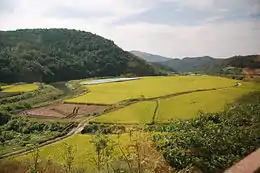Agriculture in South Korea
Agriculture in South Korea is a sector of the economy of South Korea. The natural resources required for agriculture in South Korea are not abundant. Two thirds of the country are mountains and hills. Arable land only accounts for 22 percent of the country's land. The most important crop in South Korea is rice, accounting about 90 percent of the country's total grain production and over 40 percent of farm income. Other grain products heavily rely on imports from other countries.[1] Farms range in size from small, family-owned farms to large corporations, but most are small-scale and rely heavily on government support and services in order to survive.[2]

With the rapid growth of South Korea's economy and urbanization, areas of farmland have been decreasing and rural populations have moved from the countryside to cities.[1] In addition to the decrease in farmland, there has been a decrease in rice demand due to the declining rates of rice consumption. In 1980, the average consumption of rice per capita was 137.7 kg. In 2018, only 61 kg of rice was eaten per capita.[3] This decrease is partially due to the rising of wheat consumption of consumers. In 2016, the average South Korean consumed 33.2 kg of wheat flour.[4]
National Agricultural Cooperative Federation (NACF) is South Korea's Agricultural cooperative, which is a nationwide organization in charge of agriculture banking, supply of agriculture input factors and sales of agriculture products. The NACF was founded in 1961 with the goal of "improving the economic, social, cultural and status of agriculture people and enhancing the competitiveness of agriculture to improve the quality of life of farmers and contribute to the balanced development of the national economy.[5]
In November of 2011, the government passed the Act on Development and Support of Urban Agriculture (Act of UA). It was based upon the National Land Planning and Utilization Act which strives to create more farmland. The goal of the Act of UA was to "develop a nature-friendly urban environment and contribute to the harmonious development of cities and rural communities by raising urban residents' understanding in agriculture". Seoul, South Korea's capital and largest, densest city, developed four categories of UA: "housing" which includes private homes and apartments, both indoors and outdoors; "in-city" which is the rooftops of public buildings; "farm-park" which uses abandoned land; and "education" which includes schools and colleges. To promote the idea of urban agriculture, the municipal government of Seoul offered agricultural training classes and supplies such as seeds, tools, and containers to interested residents. By 2015, the municipal government had assisted in the development of "vegetable gardens on the rooftops of 267 buildings" and had provided "43,785 box-typed vegetable pots for 15,866 places". In 2011, 29-ha were set aside in Seoul for the purpose of urban agriculture. By 2015, 118-ha were reserved for UA.[6]
Due to challenges with an aging population of farmers, a shrinking number of farm laborers, the weakening of the Korea domestic farm market, and uncommon weather patterns, the government of South Korea has been promoting the idea of smart farms to farmers. By offering financial and training support, the government is hoping to "bolster the competitiveness of domestic agriculture". These smart farms use information and communication technologies (ICT) to send real time information to mobile devices to farmers. Though the government has promoted smart farms, only a small percentage of farms has begun using the ICT. Most farmers are poor and do not have the finances to invest in technology. Also, most small farmers do not have the technological skills to change over to a "digital environment".[2] In 2019, the agricultural ministry announced that 248 billion won would be budgeted for promoting smart farm technology.[7]
Production
South Korea produced, in 2018:
- 5.1 million tons of rice (15th largest producer in the world);
- 3.3 million tons of vegetable;
- 2.5 million tons of cabbage (4th largest producer in the world, losing only to China, India and Russia);
- 1.5 million tons of onion (13th largest producer in the world);
- 646 thousand tons of tangerine;
- 553 thousand tons of potato;
- 534 thousand tons of watermelon;
- 475 thousand tons of apple;
- 346 thousand tons of persimmon (3rd largest producer in the world, losing only to China and Spain);
- 344 thousand tons of tomato;
- 333 thousand tons of cucumber;
- 331 thousand tons of garlic;
- 321 thousand tons of pumpkin;
- 314 thousand tons of sweet potato;
- 230 thousand tons of pepper;
- 213 thousand tons of strawberry (7th largest producer in the world);
- 205 thousand tons of peach;
- 203 thousand tons of pear;
- 177 thousand tons of grape;
- 167 thousand tons of melon;
In addition to smaller productions of other agricultural products.[8]
See also
References
- "Agriculture". Federal Research Division of the Library of Congress. Retrieved 2015-08-07.
- Yoon, Cheolho; Lim, Dongsup; Park, Changhee (July 2020). "Factors affecting adoption of smart farms: The case of Korea". Computers in Human Behavior. 108: 106309. doi:10.1016/j.chb.2020.106309.
- "koreanherald.com". www.koreanherald.com. Retrieved 2020-12-10.
- "South Koreans are eating more bread than rice and noodle". The Straits Times. January 12, 2018. Retrieved December 9, 2020.
- "history". Nonghyup. Retrieved December 9, 2020.
- Oh, Joo-seok; Kim, Sei-yong (December 2017). "Enhancing urban agriculture through participants' satisfaction: The case of Seoul, Korea". Land Use Policy. 69: 123–133. doi:10.1016/j.landusepol.2017.04.053. ISSN 0264-8377.
- "Korea to invest 248 billion won in smart farming in 2020". The Korean Times. September 3, 2019. Retrieved December 9, 2020.
- South Korea production in 2018, by FAO
Further reading
- 통계로 본 세계 속의 한국농업. 한국농촌경제연구원: 박한울, 박지원. March 2016.